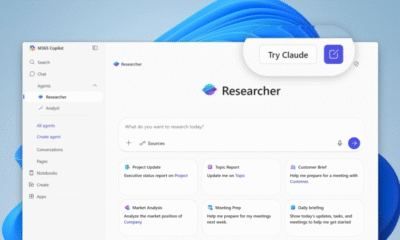AI
Exploring the Inner Workings of Advanced AI Agents: A Comprehensive Technical Guide to the Future of AI Technology

The Rise of AI Agents: Revolutionizing the World of Artificial Intelligence
In today’s fast-paced world, AI agents have taken the center stage in the realm of Artificial Intelligence. These intelligent agents are making waves as they autonomously handle a myriad of tasks on behalf of users. From making online purchases and building software to researching business trends and booking travel, AI agents are redefining the way we interact with technology.
By unleashing generative AI from the confines of chat interfaces and allowing it to directly impact the real world, agentic AI represents a monumental leap forward in the power and utility of AI technology. The evolution of AI agents has been rapid, with innovative concepts like the model context protocol (MCP) paving the way for cutting-edge agent development.
Demystifying the Agentic AI Ecosystem
Defining an “agent” can be quite complex, but at its core, an agent is an entity that runs tools in a loop to achieve a specific goal. In the case of AI agents, a large language model (LLM) is prompted with a goal, such as booking a restaurant table near a theater. The LLM then leverages a set of tools at its disposal, like restaurant databases or user preferences, to plan and execute actions that lead to goal attainment.
Building an AI agent requires several key components:
- Agent Development Framework: Utilizing frameworks to streamline the agent creation process.
- AI Model Execution: Running AI models efficiently with the right hardware and software setup.
- Agentic Code Execution: Running the agent’s code, often in the cloud for scalability.
- Tool Integration: Facilitating communication between the LLM and various tools.
- Short-term Memory: Tracking current interactions and data.
- Long-term Memory: Recording user preferences and interactions across sessions.
- Execution Tracing: Evaluating the agent’s performance and actions.
Each of these components plays a crucial role in the seamless functioning of an AI agent.
Architecting AI Agents: The Building Phase
Enhancing the performance of AI models involves a concept known as “chain-of-thought reasoning,” where agents combine thoughts, actions, and observations to achieve goals effectively. ReAct models, based on the thought-action-observation sequence, are integral to the success of modern agentic systems.
AI agents leverage a diverse array of tools, including local and remote resources like databases and microservices, to execute tasks efficiently. Developers can enable agents to create their own tools or generate code dynamically to automate repetitive tasks, enhancing overall productivity.
Runtime Environment: Ensuring Efficiency and Security
Server isolation in shared environments has evolved, with technologies like Amazon Web Services’ Firecracker introducing microVMs for efficient and secure code execution. Session-based isolation ensures each agent session operates within its dedicated microVM, ensuring secure and optimal resource utilization.
Enabling Tool Communication: The Role of MCP
Effective communication between AI agents and tools is facilitated by standards like the model context protocol (MCP). MCP sets the framework for seamless data exchange between the LLM and dedicated servers, enhancing the interoperability of agents across various platforms.
For scenarios where tools lack APIs, services that mimic human interactions with websites can bridge the gap, expanding the capabilities of AI agents to access a wide range of online resources.
Authorization Mechanisms: Securing Agent Operations
Authorization mechanisms in AI agents ensure secure access to user data and networked resources. Approaches like OAuth enable seamless authentication processes without compromising user credentials, safeguarding sensitive information during agent interactions.
Memory Management and Observability: Enhancing Agent Performance
AI agents rely on short-term and long-term memory to store critical information and user preferences across sessions. Leveraging memory summarization and chunking techniques, agents optimize data retrieval and utilization for efficient task execution.
Observability tools play a vital role in monitoring and auditing agent behavior, providing insights into performance metrics and user satisfaction levels. Tracing agent interactions offers valuable data for refining and enhancing agent capabilities.
As the realm of agentic AI continues to evolve, understanding the core components and functionalities of AI agents is essential for building robust and efficient systems. Embracing the potential of AI agents opens up a world of possibilities, empowering users to harness the full capabilities of artificial intelligence.
-

 Facebook3 days ago
Facebook3 days agoWarning: Facebook Creators Face Monetization Loss for Stealing and Reposting Videos
-

 Facebook4 days ago
Facebook4 days agoInstaDub: Meta’s AI Translation Tool for Instagram Videos
-

 Facebook4 days ago
Facebook4 days agoFacebook Compliance: ICE-tracking Page Removed After US Government Intervention
-

 Video Games4 days ago
Video Games4 days agoGoku Takes on the Dragon Ball FighterZ Arena
-

 Cars3 days ago
Cars3 days agoRevving into the Future: Ferrari’s Plan to Unleash 20 New Models, Including Electric Vehicles, by 2030
-

 Video Games5 days ago
Video Games5 days agoTekken 8: Rise of the Shadows
-

 Amazon5 days ago
Amazon5 days agoNeil Young Takes a Stand: Pulling Music from Amazon in Protest of Jeff Bezos’ Support for Trump
-

 Microsoft3 days ago
Microsoft3 days agoMicrosoft Integrates Anthropic’s Claude AI Models into 365 Copilot: A Deepening Relationship with OpenAI





























